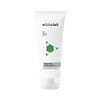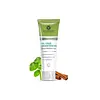What's inside
What's inside
 Key Ingredients
Key Ingredients

 Benefits
Benefits

 Concerns
Concerns

No concerns
 Ingredients Side-by-side
Ingredients Side-by-side

Water
Skin ConditioningPalmitic Acid
EmollientLauric Acid
CleansingPotassium Hydroxide
BufferingStearic Acid
CleansingGlycerin
HumectantSodium Chloride
MaskingCocamidopropyl Betaine
CleansingSodium Laureth Sulfate
CleansingGlyceryl Stearate
EmollientSalicylic Acid
MaskingCentella Asiatica Extract
CleansingArtemisia Capillaris Extract
Hexamidine Diisethionate
EmollientMelaleuca Alternifolia Leaf Oil
AntioxidantCocamide DEA
EmulsifyingAcrylates Copolymer
Glycol Stearate
EmollientPotassium Cocoate
EmulsifyingParfum
MaskingDMDM Hydantoin
PreservativePolyquaternium-7
Tetrasodium EDTA
Iodopropynyl Butylcarbamate
PreservativeWater, Palmitic Acid, Lauric Acid, Potassium Hydroxide, Stearic Acid, Glycerin, Sodium Chloride, Cocamidopropyl Betaine, Sodium Laureth Sulfate, Glyceryl Stearate, Salicylic Acid, Centella Asiatica Extract, Artemisia Capillaris Extract, Hexamidine Diisethionate, Melaleuca Alternifolia Leaf Oil, Cocamide DEA, Acrylates Copolymer, Glycol Stearate, Potassium Cocoate, Parfum, DMDM Hydantoin, Polyquaternium-7, Tetrasodium EDTA, Iodopropynyl Butylcarbamate
Water
Skin ConditioningXanthan Gum
EmulsifyingSodium Acrylates Crosspolymer-2
AbsorbentSodium Allantoin PCA
Skin ConditioningChlorphenesin
AntimicrobialPhenoxyethanol
PreservativeGlycerin
HumectantPropanediol
SolventSodium Hyaluronate
HumectantCentella Asiatica Extract
CleansingCinnamomum Zeylanicum Bark Extract
AntimicrobialPanthenol
Skin ConditioningNiacinamide
SmoothingRoyal Jelly
Arbutin
AntioxidantResveratrol
AntioxidantPolyquaternium-7
 Reviews
Reviews

Ingredients Explained
These ingredients are found in both products.
Ingredients higher up in an ingredient list are typically present in a larger amount.
Centella Asiatica Extract (Centella) is derived from an herb native to Southeast Asia. It is famous for its anti-inflammatory and soothing properties.
Centella is rich in antioxidants and amino acids, such as Madecassic Acid and Asiaticoside.
Studies show the compounds in centella help with:
The combination of all these properties makes centella effective at soothing, hydrating, and protecting the skin.
Other great components of centella include Vitamin A, vitamin C, several B vitamins, and Asiatic Acid.
Fun fact: Centella has been used as a medicine and in food for many centuries. As a medicine, it is used to treat burns, scratches, and wounds.
Learn more about Centella Asiatica ExtractGlycerin is already naturally found in your skin. It helps moisturize and protect your skin.
A study from 2016 found glycerin to be more effective as a humectant than AHAs and hyaluronic acid.
As a humectant, it helps the skin stay hydrated by pulling moisture to your skin. The low molecular weight of glycerin allows it to pull moisture into the deeper layers of your skin.
Hydrated skin improves your skin barrier; Your skin barrier helps protect against irritants and bacteria.
Glycerin has also been found to have antimicrobial and antiviral properties. Due to these properties, glycerin is often used in wound and burn treatments.
In cosmetics, glycerin is usually derived from plants such as soybean or palm. However, it can also be sourced from animals, such as tallow or animal fat.
This ingredient is organic, colorless, odorless, and non-toxic.
Glycerin is the name for this ingredient in American English. British English uses Glycerol/Glycerine.
Learn more about GlycerinPolyquaternium-7 is a light to clear colored liquid. It is commonly found in haircare products for its film-forming and anti-static properties.
According to a manufacturer, it is a non-paraben and specially developed for negatively charged surfactant systems. This makes it a great hairstyle holder and helps to improve wet hair detangling without adding buildup.
Water. It's the most common cosmetic ingredient of all. You'll usually see it at the top of ingredient lists, meaning that it makes up the largest part of the product.
So why is it so popular? Water most often acts as a solvent - this means that it helps dissolve other ingredients into the formulation.
You'll also recognize water as that liquid we all need to stay alive. If you see this, drink a glass of water. Stay hydrated!
Learn more about Water